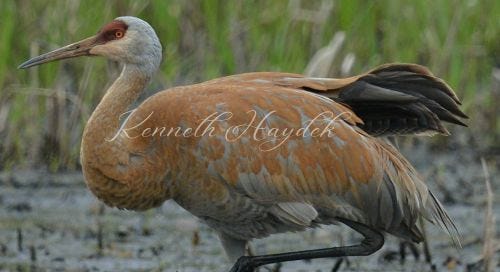December: Sandhill Cranes
Best described as “elegant,” with long bodies suited to dancing and deep harmonic trills, the sight of sandhill cranes never seems to disappoint, whether spotted as a pair walking through marshy ground or in flocks of hundreds in the air.
These birds seem to be all about making an impression. Their size alone is noteworthy: adults are four feet long, with a wingspan of six-and-a-half feet, and weigh about ten pounds. They are pale gray with pale cheeks and a crown of red skin. Juveniles lack the red crown. Each spring—and sometimes even later in the year—sandhill cranes dye their gray feathers with iron-rich mud, adding vibrant warm rust colors to their cool gray feathers. Sandhill cranes do not cake mud on themselves, but rather carefully apply the mud—as if cosmetically—to incorporate the color into their feathers rather than simply coat the top. The reason for their feather-dying is unknown; while some have speculated that feather-dying has to do with breeding; however, sandhill cranes will dye their feathers outside of breeding season if they have access to this mud, so the mystery remains.
Sandies have long black legs, a straight pointed bill that is longer than its head, and a short, feather-duster-like tail. With their long windpipes, they produce deep rich calls that can be quite striking, especially when flying overhead. Notably, when cranes fly, they extend their necks, whereas herons tuck them in.
There are six subspecies of sandhill cranes. Three subspecies do not migrate—the Mississippi, the Florida, and the Cuba—and each subspecies lives where the name suggests. Three others—the Lesser, the Greater, and the Canadian—do migrate, with varying migration ranges, some going to breeding grounds as far north as the Bering Strait. Habitats of these birds vary by location, but they all tend toward marshy areas, bogs, and tundra. During migration they may stopover in farmlands, fields, prairies, and river valleys. About 80 percent of migratory sandhill cranes stopover in a 75-mile area along the Platte River in Nebraska during spring migration, totaling about a million visiting birds in the space of three months. In the fall, tens of thousands stopover at the Jasper-Pulaski Fish & Wildlife Area outside Chicago.
Sandhill cranes perform courtship displays in order to find their mate for life. Female sandies initiate a courtship “dance” where the birds flap, leap, and bow to each other. Having found their mates, they engage in “unison calling,” with the two tossing their heads back and singing a sort of duet toward the sky. Mates stay with each other all year, not just during breeding season. Considering that the oldest sandhill crane recorded was 37 years old, a pair of sandhill cranes may be together for decades.
Mates find nest material (reeds, cattails, grasses, stems, twigs) together, but females build the nests, which may be two-and-a-half to three feet in diameter and up to six inches high. A clutch may be as many as three eggs, usually only two, but typically just one survives to fledgling stage. Sandies can walk and swim within eight hours of hatching, but this fast progress is actually a little bit deceptive as the pace they set later in life is much slower. Juvenile sandhill cranes stay with their parents nine to ten months after hatching. While the birds are sexually mature and ready to mate by age two, some sandies may mate as late as seven years of age.
Sandhill crane families will group together with other families to form feeding flocks during migration. They eat many grains and seeds; large flocks of them can wipe out entire agricultural fields, which can be a problem for farmers. Otherwise, they may eat aquatic plants, small reptiles and rodents, and berries.
The best way to spot these birds is to know where and when they gather. You can use resources like the Sandhill Crane Finder from the International Crane Foundation to search out places where they have been seen. And listen for them—their booming bugle-like calls can be heard two-and-a-half miles away!
Sources:
https://www.allaboutbirds.org/guide/Sandhill_Crane/overview
https://www.audubon.org/field-guide/bird/sandhill-crane
https://ebird.org/species/sancra
https://www.chicagobirder.org/blog/2023/12/11/a-worthwhile-road-trip-to-see-sandhill-cranes
https://abcbirds.org/bird/sandhill-crane/
https://blog.nature.org/2024/03/20/did-you-know-sandhill-cranes-dye-their-feathers/



